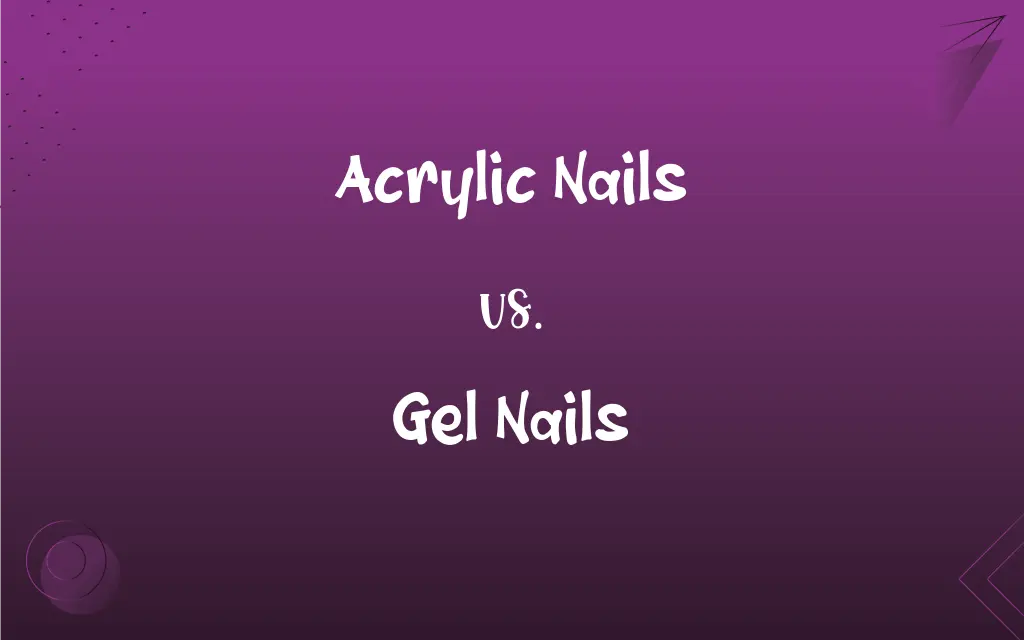Acrylic Nails vs. Gel Nails: What's the Difference?
Edited by Aimie Carlson || By Harlon Moss || Updated on October 12, 2023
Acrylic nails involve a liquid and powder mixture to create a hard protective layer over natural nails, while gel nails use a gel substance cured under UV light. Both enhance nail appearance and length.

Key Differences
Acrylic nails are celebrated for their durability and robustness, offering a protective shell over one's natural nails, whereas gel nails are often hailed for their natural, glossy appearance. Acrylic solutions comprise a liquid monomer and a powder polymer, which, when combined, create a hard protective layer. Contrastingly, gel nails employ a gel-based polish that requires UV light to cure and solidify.
In terms of aesthetic longevity, acrylic nails might typically outlast their gel counterparts, boasting a sturdier form that can endure more physical strain. Gel nails, while relatively durable, present a somewhat more natural look and feel but may be more prone to chips and wear over time when compared to acrylic options.
Application processes differ notably; acrylic nails involve carefully applying the aforementioned mixture and allowing it to harden, whereas gel nails necessitate an application of gel polish, followed by a curing period under UV light. Gel nails typically involve less fuming and odor during the application process than acrylic nails.
Removal processes for acrylic and gel nails are also varied; acrylics require soaking in acetone and gentle removal, often through filing and professional guidance. Gel nails too necessitate a soak in acetone but usually peel off more readily post-soaking, with meticulous care still being paramount.
Both acrylic and gel nails offer a myriad of stylistic and color options, presenting opportunities for aesthetic expression and nail art. While acrylic nails offer perhaps more structural volume and length, gel nails provide a lustrous, semi-natural aesthetic appealing to those who prefer a more subtle enhancement.
ADVERTISEMENT
Comparison Chart
Material Basis
Liquid and powder mixture.
Gel-based polish.
Durability
Known for robust durability.
Durable but may chip more easily than acrylic.
Application Process
Mix applied and allowed to harden.
Gel applied and cured under UV light.
Removal Process
Requires soaking and gentle filing for removal.
Necessitates soaking but usually peels off post-soak.
Appearance
Offers volume and is more evidently artificial.
Yields a glossy, semi-natural aesthetic.
ADVERTISEMENT
Acrylic Nails and Gel Nails Definitions
Acrylic Nails
Acrylic nails are extensions placed over natural nails.
She adorned her hands with acrylic nails for added length.
Gel Nails
Gel nails require curing under UV light post-application.
After applying the gel, her nails were placed under a UV lamp.
Acrylic Nails
A mix of liquid and powder forms the base of acrylic nails.
The technician meticulously mixed and applied the acrylic nails mixture.
Gel Nails
Gel nails can be applied over natural nails or extensions.
She opted for gel nails over her natural nail length.
Acrylic Nails
Removal of acrylic nails necessitates soaking and careful filing.
She visited the salon for the safe removal of her acrylic nails.
Gel Nails
Known for a glossy finish, gel nails offer a natural aesthetic.
Her gel nails shimmered with a natural, glossy finish.
Acrylic Nails
Acrylic nails can be shaped, colored, and designed versatilely.
Her acrylic nails were sculpted into an elegant almond shape.
Gel Nails
Gel nails are achieved using a UV-curable gel-based polish.
She chose a pink shade for her gel nails this week.
Acrylic Nails
Known for durability, acrylic nails withstand wear.
Despite various chores, her acrylic nails remained impeccable.
Gel Nails
Gel nail removal involves soaking and gentle peeling.
Gel nails often peel off easily after a proper acetone soak.
FAQs
Are acrylic nails safe?
Yes, when applied and removed properly by a professional.
Can gel nails be filled?
Yes, the gap from growth can be filled every 2-3 weeks.
How are acrylic nails removed?
Typically, they are soaked in acetone and gently removed.
How much do gel nails typically cost?
It ranges but often starts from $25-$60, depending on the salon and design.
How are acrylic nails applied?
Acrylics are applied by mixing a liquid and powder, forming a gel that's shaped on the natural nail and then hardened.
How long do acrylic nails last?
They can last 3-4 weeks with proper care before needing a fill.
Can acrylic nails be filled?
Yes, the growth gap can be filled every 2-3 weeks.
Can acrylic nails be shortened?
Yes, they can be filed down to shorten or reshape them.
How are gel nails applied?
Gel is applied in layers and then cured under a UV or LED light.
How long do gel nails last?
They can last up to 2-3 weeks with proper care.
Are gel nails safe?
Generally safe, though there's a risk of skin aging and damage with frequent UV exposure.
Can gel nails be used to lengthen nails?
Gel extensions are available, though traditional gel nails are not used for lengthening.
Do acrylic nails damage natural nails?
Yes, they can cause some weakening and thinning of the natural nails.
How much do acrylic nails usually cost?
Prices vary, usually starting from $30-$50, depending on the location and design.
What are gel nails?
Gel nails involve applying a semi-liquid substance that is then cured under a UV light.
How are gel nails removed?
They should be soaked in acetone and gently removed.
Are gel nails flexible or hard?
Gel nails are slightly more flexible than acrylics.
What are acrylic nails?
Acrylic nails are artificial extensions made with a powder and a liquid monomer to create a hard protective layer.
Can I paint over acrylic nails?
Yes, they can be painted and repainted as desired.
Do gel nails damage natural nails?
They can, if not applied and removed correctly.
About Author
Written by
Harlon MossHarlon is a seasoned quality moderator and accomplished content writer for Difference Wiki. An alumnus of the prestigious University of California, he earned his degree in Computer Science. Leveraging his academic background, Harlon brings a meticulous and informed perspective to his work, ensuring content accuracy and excellence.
Edited by
Aimie CarlsonAimie Carlson, holding a master's degree in English literature, is a fervent English language enthusiast. She lends her writing talents to Difference Wiki, a prominent website that specializes in comparisons, offering readers insightful analyses that both captivate and inform.































































